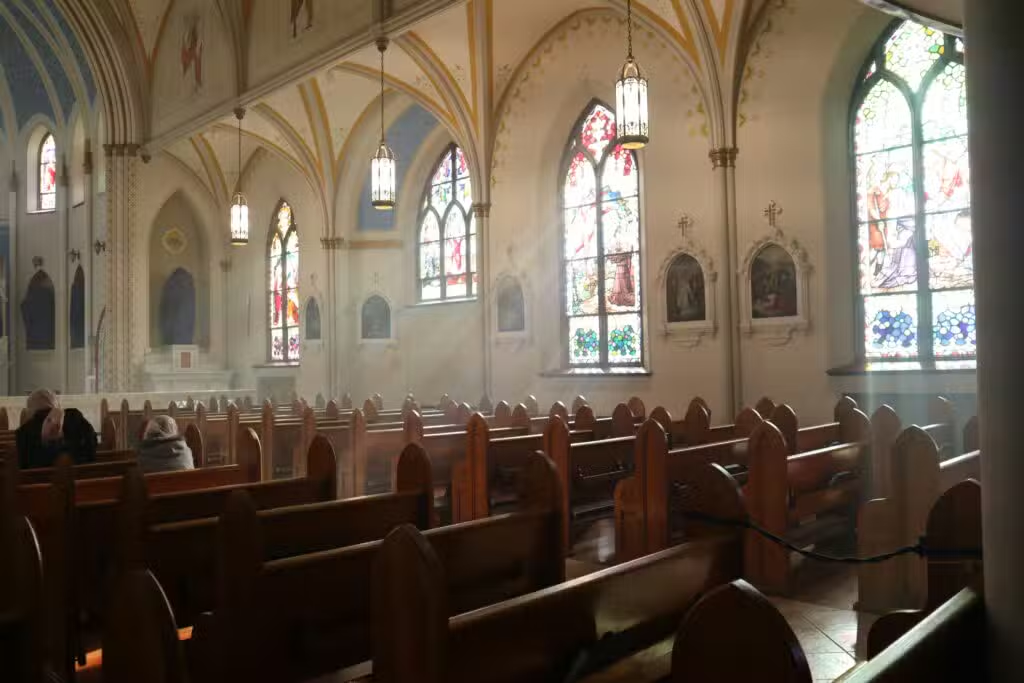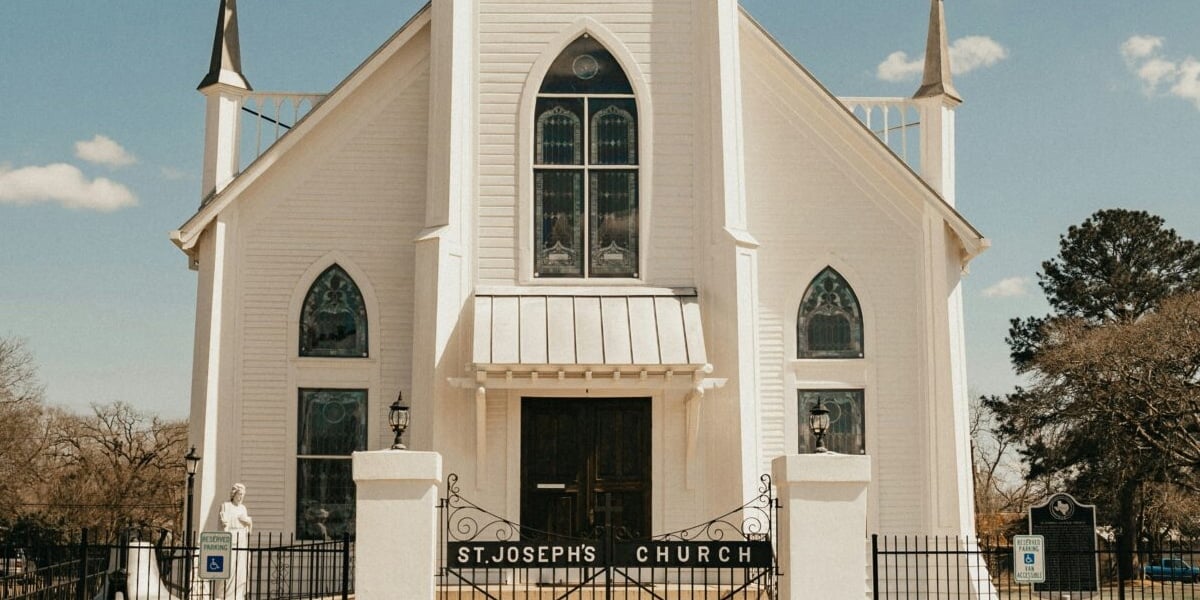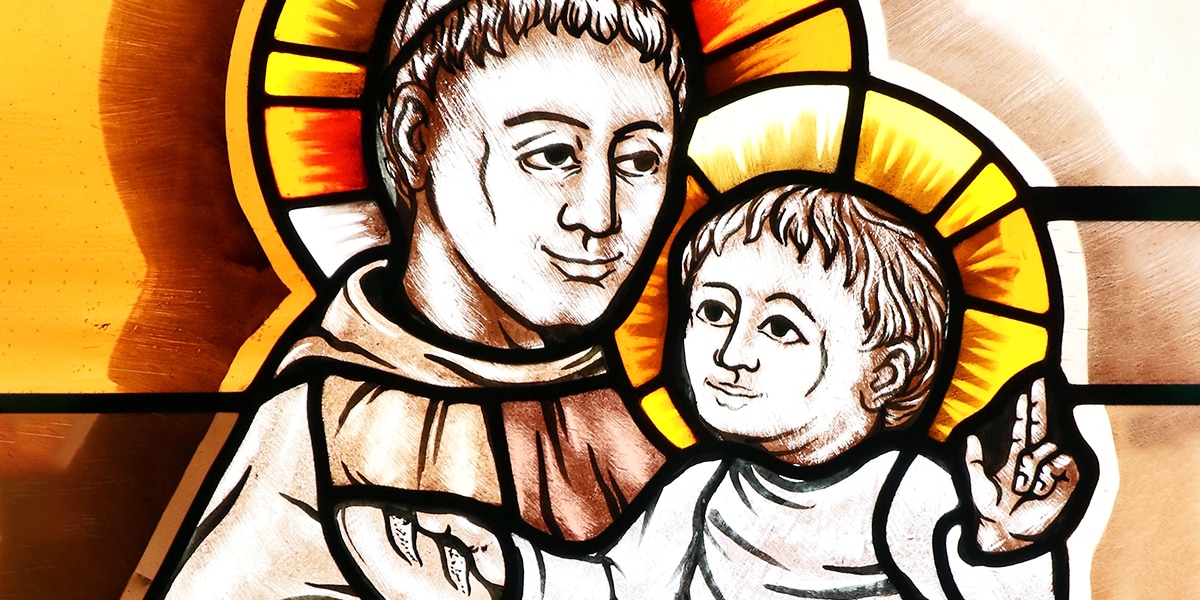Next time you’re at church, stop and look around. You might be surprised by what you find.
I love those first few moments of entering into beautifully decorated Catholic churches—often found in older neighborhoods. These impressive works of architecture and breathtaking art feel almost European, and I feel instantly warm and embraced by the many colorful windows, designs, statues—even the creaky wooden pews have a certain appeal.
Simultaneously, I love stark churches, lacking much design and ornamentation, but rich in stillness and simplicity. Both types feel inviting to prayer and contemplation in their own ways. Whether rich with art or full of simplicity, all churches have much to offer our eyes and soul to contemplate, to nudge our hearts closer to the Lord.
So much of our faith acquisition is through auditory means: homilies, Bible studies, CCD classes, and the like tend to rely heavily on the ability to listen. If you tend to be more of a visual learner, however, having a smattering of artifacts, symbols, and designs for your eyes to absorb can up your spiritual intake. Adding another sense into the learning process, by viewing the motifs and representations presented in your church, can greatly help to enrich your beliefs.
What Do You See?
It would be impossible to list every piece of artwork found in Catholic churches throughout the world, but we can explore a sampling of some of the more popular visuals you may have seen.
Chi Rho
Even the plainest churches often have a Chi Rho (kee row) insignia somewhere—perhaps on the altar, on the priest’s vestments, or imprinted on the tabernacle. The “X” over the “P” is a monogram for the first two Greek letters of the word “Christ” (XPICTOC): a decorative yet subtle reminder that Jesus is Christ, “the anointed one.”
INRI
Also found in most (hopefully all) Catholic churches is at least one crucifix with the initials INRI inscribed at the top. These four letters represent the first letter of four different Latin words: Iesus Nazarenus Rex Iudaeorum, which means “Jesus of Nazareth, King of the Jews.” These words were posted on the top of Jesus’ cross by Pontius Pilate. He actually had these words posted in Hebrew, Latin, and Greek. The label upset the chief priests present, but Pilate ignored their annoyance.
“So the chief priests of the Jews said to Pilate, ‘Do not write “The King of the Jews,” but that he said, “I am the King of the Jews.”’ Pilate answered, ‘What I have written, I have written’” (Jn 19:21-22).
Gospel Symbols
Occasionally you might find carvings, paintings, or windows of four winged creatures clustered together. These beings became symbols of the Church’s four Gospel writers. The winged man represents Matthew, the lion stands for Mark’s Gospel, the ox is for Luke, and the eagle symbolizes John’s Gospel. These four unique creatures are drawn from the Old Testament Book of Ezekiel (1:10 and 10:14) and the New Testament Book of Revelation (4:7-8).
“Their faces were like this: each of the four had the face of a man, but on the right side was the face of a lion, and on the left side the face of an ox, and finally each had the face of an eagle” (Ez 1:10).
Altar
All Catholic churches have altars, usually found toward the front of the church. Older altars have a relic of a saint—often the patron saint of the church—embedded within the top slab of the altar. The altar is where the Last Supper is repeated; where the consecration and transubstantiation of the bread and wine occur.
“When it was evening, he reclined at table with the Twelve. . . . While they were eating, Jesus took bread, said the blessing, broke it, and giving it to his disciples said, ‘Take and eat; this is my body’” (Mt 26:20, 26).
Tabernacle
The tabernacle is a medium-sized, often ornate container, usually near the altar or in a side chapel. The tabernacle holds consecrated hosts, and so is kept locked when not in use. A burning light is kept near the tabernacle to symbolize its divine contents. The word tabernacle is derived from Latin for “tent”; its use parallels the Dwelling constructed during the Exodus (chapters 25-27, 30-31, 35-40).
“They shall make a sanctuary for me, that I may dwell in their midst” (Ex 25:8).
Statues
Lots of churches have statues of saints to help Catholics recall the lives of people who exemplified living for the glory of God. One popular statue found in many churches is of Saint Anthony, an early Franciscan known for his profound preaching abilities. Although he is called Saint Anthony of Padua (Italy), he actually grew up in Portugal. Saint Anthony is typically depicted in the brown Franciscan robe with his hair cut in the tonsure style. He is also usually shown holding the child Jesus, due to a report by a friend who happened upon Saint Anthonyduring the miraculous occurrence.
Saint Thérèse of the Child Jesus is another common statue found in Catholic churches. This young saint from France died when she was only 24, yet still became widely known and eventually recognized as a doctor of the Church (as is Saint Anthony). She is typically displayed wearing her brown Carmelite habit and holding a bouquet of roses with a crucifix nestled within.

The crucifix symbolizes Thérèse’s devotion to the Lord and how she frequently held a crucifix in her hands toward the end of her life. The roses symbolize a statement she once made to her oldest sister (both blood and religious), Sister Marie of the Sacred Heart; that her (Thérèse’s) death would not be a time of sorrow, but rather “like a shower of roses.”
Statues of the Blessed Mother, Saint Joseph, Saint Agnes holding a lamb, Saint Dominic holding a rosary, Saint Barbara near a tower and holding a palm, Saint Francis of Assisi with a bird or wolf nearby, or a statue of the patron of the church are other common statues to be discovered.
“Moses said to the Israelites, ‘See, the LORD has . . . filled him with a divine spirit of skill and understanding and knowledge in every craft: in the production of embroidery, in making things of gold, silver, or bronze, in cutting and mounting precious stones, in carving wood, and in every other craft’” (Ex 35:30-33).
Windows
Catholic church windows come in a wide array of decor—from plain clear glass, to one-colored glass, to simple designs, to richly detailed religious depictions. Within a decorated stained-glass window, you might find a fish for the Greek word symbolizing “Jesus Christ, Son of God, Savior,” a butterfly representing Christ’s resurrection, a portrayal of Saint Patrick banishing snakes from Ireland or holding a shamrock, Saint Joan of Arc in her armor, and so on. Whether composed of simple symbols or elaborate illustrations, intriguing chunks of Church history can be gleaned through many church windows.
Stations of the Cross
The Stations of the Cross, sets of 14 bas-reliefs or images spread throughout the church, offer a thought-provoking pilgrimage. They cleverly connect 14 key events from Jesus’ passion, beginning with his condemnation by Pilate until his entombment. These sets of images are most frequently used during Lent, but truly can be contemplated during any time of the year. Whether you pick one station to ponder and pray about, or go through all 14, these renderings can help viewers to better grasp the sacrifice of Christ.
So Much More
Let these religious motifs and many others teach you, encourage your spiritual life, and draw you closer to the Lord. Let them enhance your knowledge of Church history, lives of the saints, Bible stories, and Catholic doctrine. Whether plain or elaborate, sacred art can be a beautiful (pun intended) opportunity to learn about and assist in teaching the word of God.








